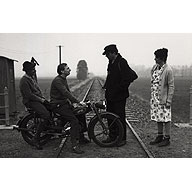Christian Wagner on Wallers last trip
The old track inspector WaIler still walks down his old section of the railway line even though he is now retired and his single-track branch line in a valley in the AIIgäu is due to be shut down. Day after day, step after step, sleeper for sleeper, he walks down the railway lines inspecting points, signals, bridges and rails. On his final inspection, he goes through time, as time has gone through him. Station for station, he goes through the phases of his life as he walks along the railway lines. The interplay between the various time levels and the blurring of present and past give rise to a meditation on change and progress. The further WaIler goes, the more deteriorated and overgrown the railway line, stations and installations become. At the end, one has the impression that this railway line has been disused for many years. As WaIler passes the final buffer, it is as if the metamorphosis of the railway line has been completed: all that can be seen is the gravel railway embankment, like a thin strip weaving its way through the countryside; hip-high grass accompanies WaIler on the final phase of his journey into. no-man's-land.
Perhaps my preoccupation with thinking in pictures stems from the fact that during my childhood and youth I spent a great deal of time out in the countryside, in the mountains. Images of the countryside are therefore a key form of expression, because they evoke a certain mood and are a kind of mirror for the soul, a huge screen on which the world of the imagination and the viewer's power to create images can be projected: what we see is basically that which lies buried within ourselves. The quiet sequences during WaIler's inspection round allow the viewer free rein for his own thoughts and feelings.


Or, to paraphrase Michelangelo Antonioni: "Once enclosed in its riverbed, a story threatens to trickle away if one does not allow this story a life beyond itself to where we, the protagonists of all stories, live. Where nothing is enclosed."